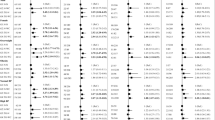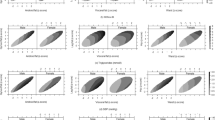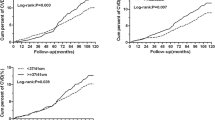Abstract
BACKGROUND: Although numerous studies have demonstrated obesity as an aspect of the insulin resistance syndrome in cardiovascular disease (CVD), the mechanism is not clear. Central adiposity, acting through many CVD risk factors, including, plasma glucose, insulin, total cholesterol, low density lipoprotein-cholesterol (LDL-C) and lipoprotein moities-apolipoprotein B (ApoB), apolipoprotein A-I (ApoAI), by atherogenic and thrombotic mechanisms has been proposed as a possible mechanism. In this study, we examined the relationship between central fat distribution (defined by waist circumference) and the ratio of these lipoproteins (ApoB/ApoAI).
SUBJECTS AND METHODS: Association between ApoB/ApoAI ratio and waist circumference was compared in Blacks (n=854) and Whites (n=2552) using the NHANES III population-based samples. Correlation analyses and multiple regression analyses were used to determine the association between ApoB/ApoAI and waist circumference, controlling for age, body mass index (BMI), race, gender, plasma glucose, insulin, serum triglyceride and total cholesterol.
RESULTS: Adjusting for age, ApoB/ApoAI was significantly correlated with waist circumference (Black men: r=0.38, White men: r=0.26, Black women: r=0.20, White women: r=0.36) (all P<0.01). Adjusting for age and triglyceride or insulin, waist circumference was also positively correlated with CVD risk factors including, ApoB, LDL-C, plasma glucose and fasting insulin, and inversely correlated with ApoAI and HDL-C in Blacks and Whites (P<0.05). Overall, triglyceride and total cholesterol were the strongest predictors of ApoB/ApoAI in Blacks and Whites adjusting for age, BMI and insulin, than waist girth (P<0.01).
CONCLUSIONS: The result of this study suggests the need to investigate ApoB/ApoAI as another possible facet in the insulin resistant syndrome.
This is a preview of subscription content, access via your institution
Access options
Subscribe to this journal
Receive 12 print issues and online access
$259.00 per year
only $21.58 per issue
Buy this article
- Purchase on Springer Link
- Instant access to full article PDF
Prices may be subject to local taxes which are calculated during checkout
Similar content being viewed by others
Author information
Authors and Affiliations
Corresponding author
Rights and permissions
About this article
Cite this article
Okosun, I., Prewitt, T., Liao, Y. et al. Association of waist circumference with ApoB to ApoAI ratio in black and white Americans. Int J Obes 23, 498–504 (1999). https://doi.org/10.1038/sj.ijo.0800849
Received:
Revised:
Accepted:
Published:
Issue Date:
DOI: https://doi.org/10.1038/sj.ijo.0800849
Keywords
This article is cited by
-
Appropriateness of waist circumference and waist-to-hip ratio cutoffs for different ethnic groups
European Journal of Clinical Nutrition (2010)
-
Relationship between fat patterns, physical fitness and blood pressure of rural South African children: Ellisras Longitudinal Growth and Health Study
Journal of Human Hypertension (2008)
-
Waist Circumference and Cardiovascular Risk Factors in Prepubertal Children
Obesity Research (2001)
-
Body fat, fat distribution and serum lipids, lipoproteins and apolipoproteins in African-American and Caucasian-American prepubertal children
International Journal of Obesity (2001)
-
Assessing abdominal fatness with local bioimpedance analysis: basics and experimental findings
International Journal of Obesity (2001)



